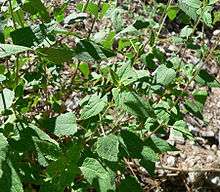Brickellia grandiflora
Brickellia grandiflora, known by the common name tasselflower brickellbush, is a species of flowering plant in the daisy family.[2]
| Brickellia grandiflora | |
|---|---|
 | |
| Scientific classification | |
| Kingdom: | |
| (unranked): | |
| (unranked): | |
| (unranked): | |
| Order: | |
| Family: | |
| Subfamily: | |
| Tribe: | |
| Genus: | |
| Species: | B. grandiflora |
| Binomial name | |
| Brickellia grandiflora | |
| Synonyms[1] | |
|
Synonymy
| |
Distribution
The plant is widespread across much of western North America, found in western Canada (Alberta, British Columbia); northern Mexico (Baja California, Sonora, Chihuahua, Coahuila, Nuevo León, Tamaulipas); and the western and midwestern United States (primarily the Rocky Mountains and regions west through California, Oregon and Washington, with additional populations in New Mexico and Texas, and the central Great Plains (Nebraska, Kansas, Oklahoma) and the Ozarks (Missouri, Arkansas).[3][4][5][6]
Description
Brickellia grandiflora is an upright perennial herb growing a few-branched stem up to 70 centimeters tall. The hairy, glandular leaves are up to 12 centimeters long and lance-shaped, triangular, or heart-shaped.[6]
The inflorescences at the tip of the slender stem holds clusters of nodding flower heads, each just over a centimeter long and lined with greenish phyllaries with curling tips. The bell-shaped flower head holds a spreading array of 20 to 40 disc florets. The fruit is a hairy cylindrical achene about 4 millimeters long with a pappus of bristles.[6] The bloom period is July to September.
The rust fungus Puccinia subdecora grows on Brickellia grandiflora.[7]
References
- The Plant List Brickellia grandiflora (Hook.) Nutt.
- Calflora taxon report, University of California, Brickellia grandiflora (Hook.) Nutt., Large Flowered Brickelbush, large flowered brickellia, tasselflower brickellbush
- Biota of North America Program 2014 county distribution map
- Turner, B. L. 1997. The Comps of Mexico: A systematic account of the family Asteraceae, vol. 1 – Eupatorieae. Phytologia Memoirs 11: i–iv, 1–272
- Tropicos, specimen listing for Brickellia grandiflora (Hook.) Nutt
- Flora of North America, Brickellia grandiflora (Hooker) Nuttall, Trans. Amer. Philos. Soc., n. s. 7: 287. 1840.
- George Baker Cummins: Rust Fungi on Legumes and Composites in North America. University of Arizona Press, Tucson 1978, ISBN 0-8165-0653-1
External links
- Calflora Database: Brickellia grandiflora (Large flowered brickelbush, Tasselflower brickellbush)
- Jepson Manual eFlora (TJM2) treatment of Brickellia grandiflora
- USDA Plants Profile for Brickellia grandiflora (tasselflower brickellbush)
- UC CalPhotos gallery of Brickellia grandiflora
| Wikimedia Commons has media related to Brickellia grandiflora. |